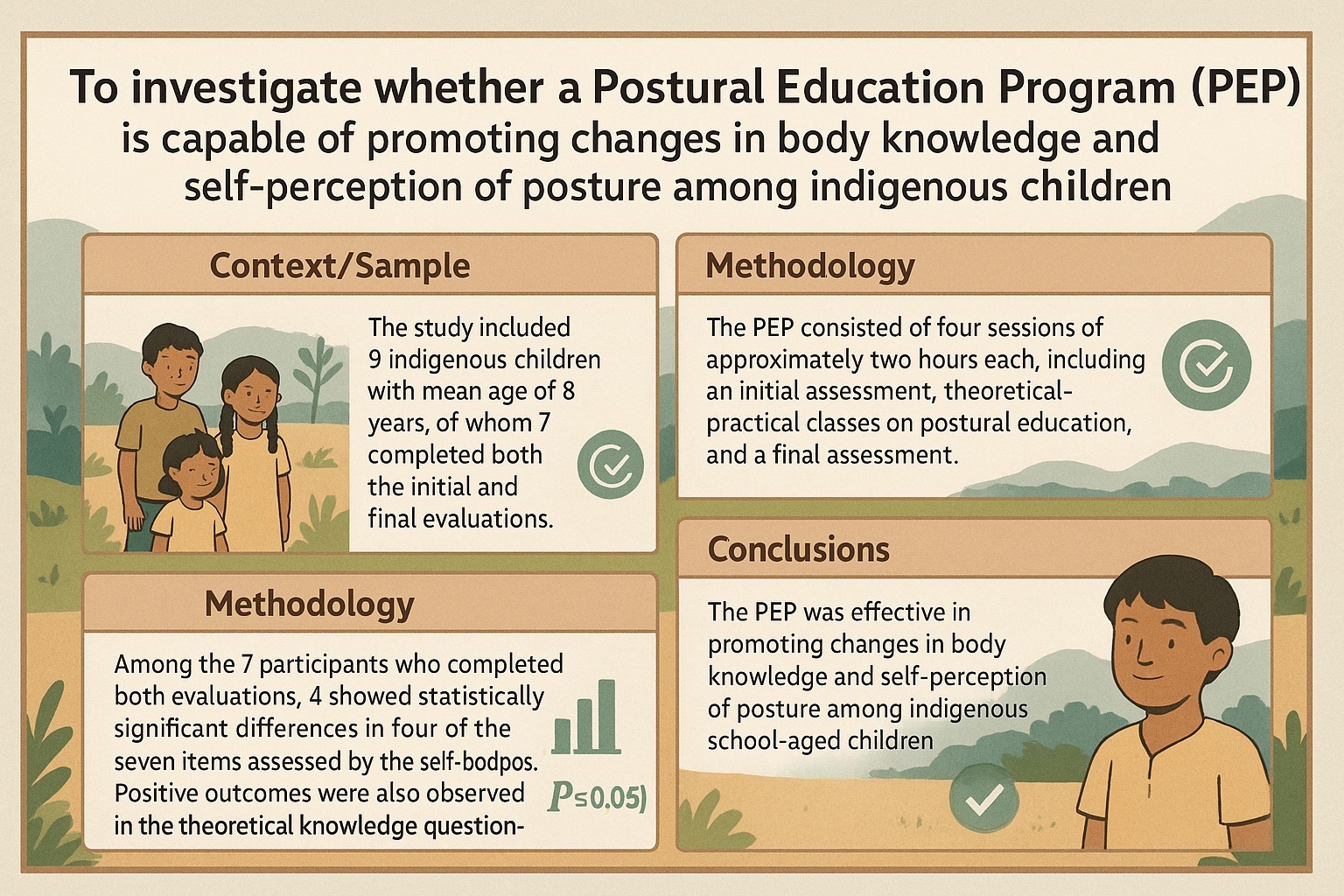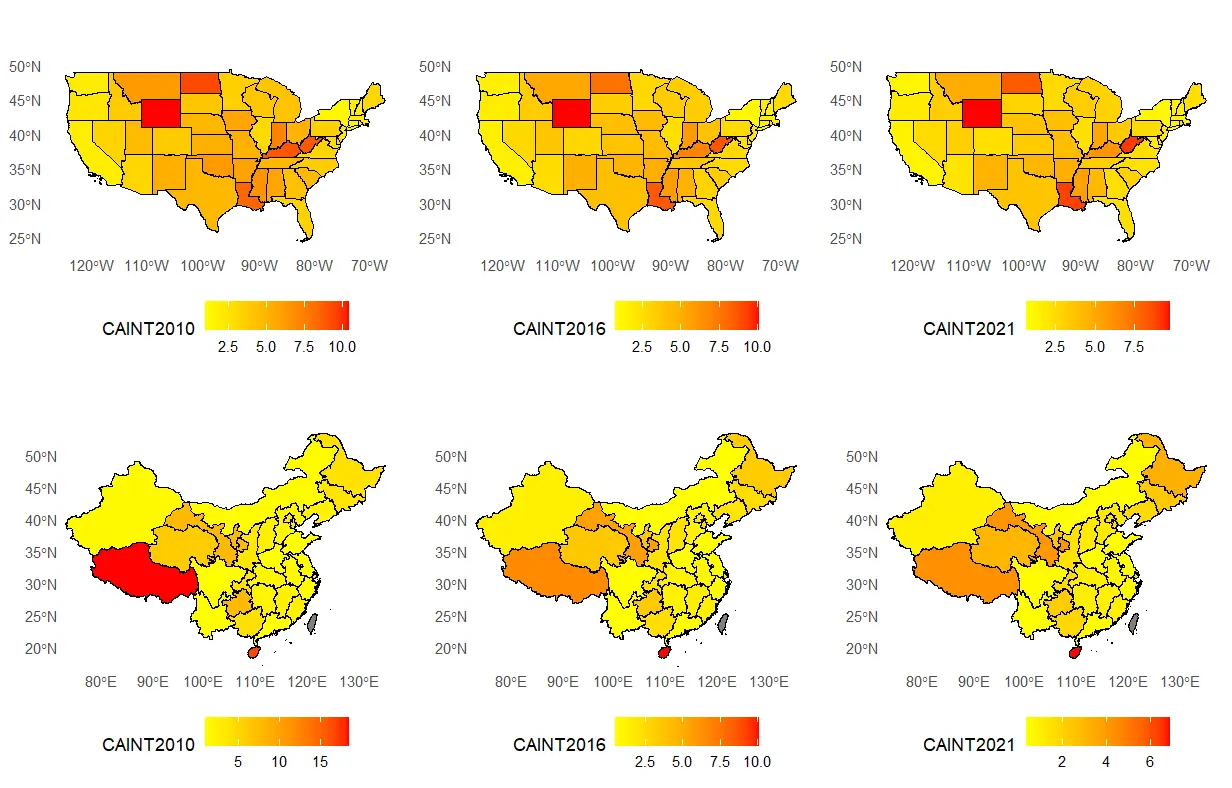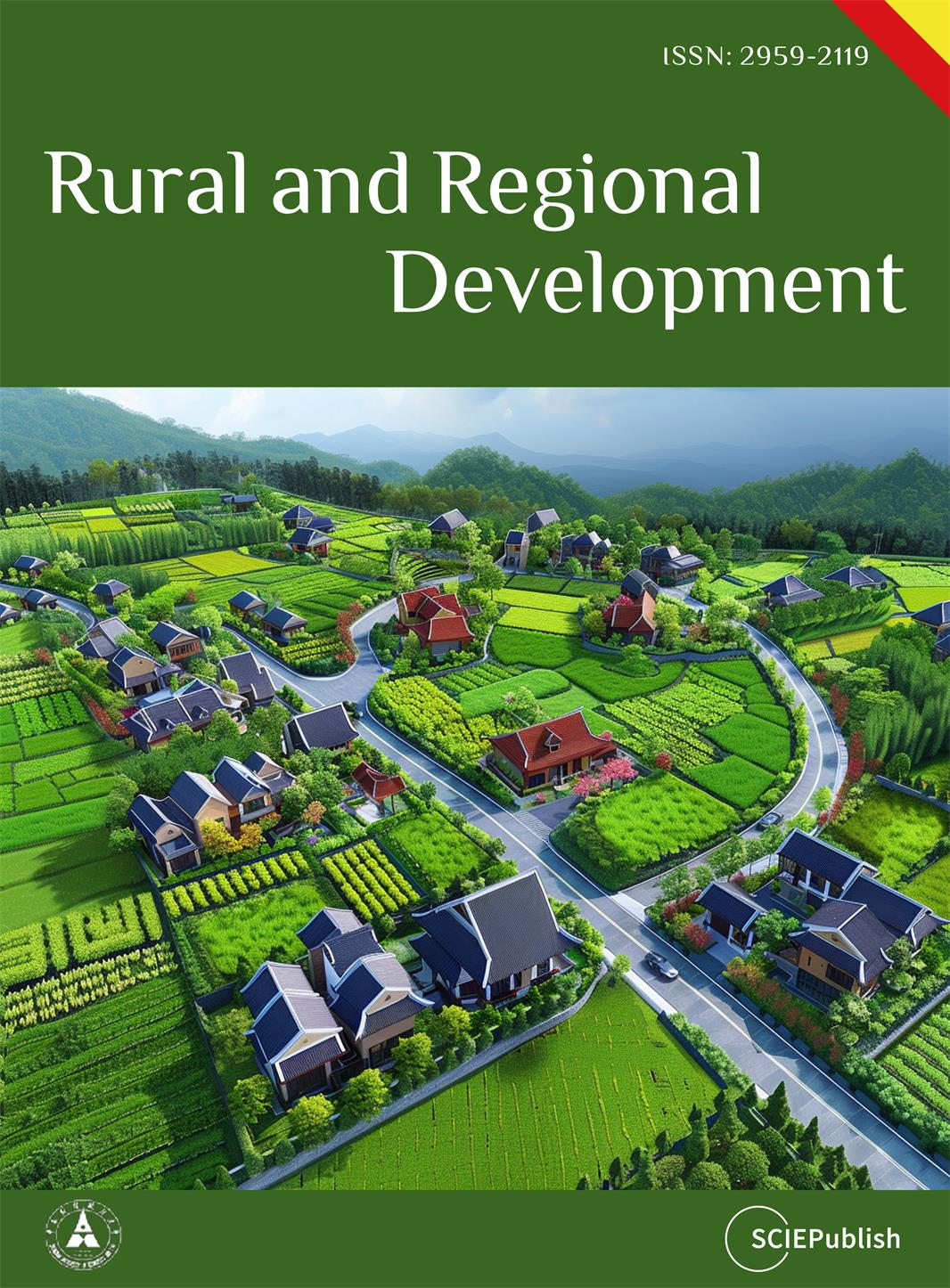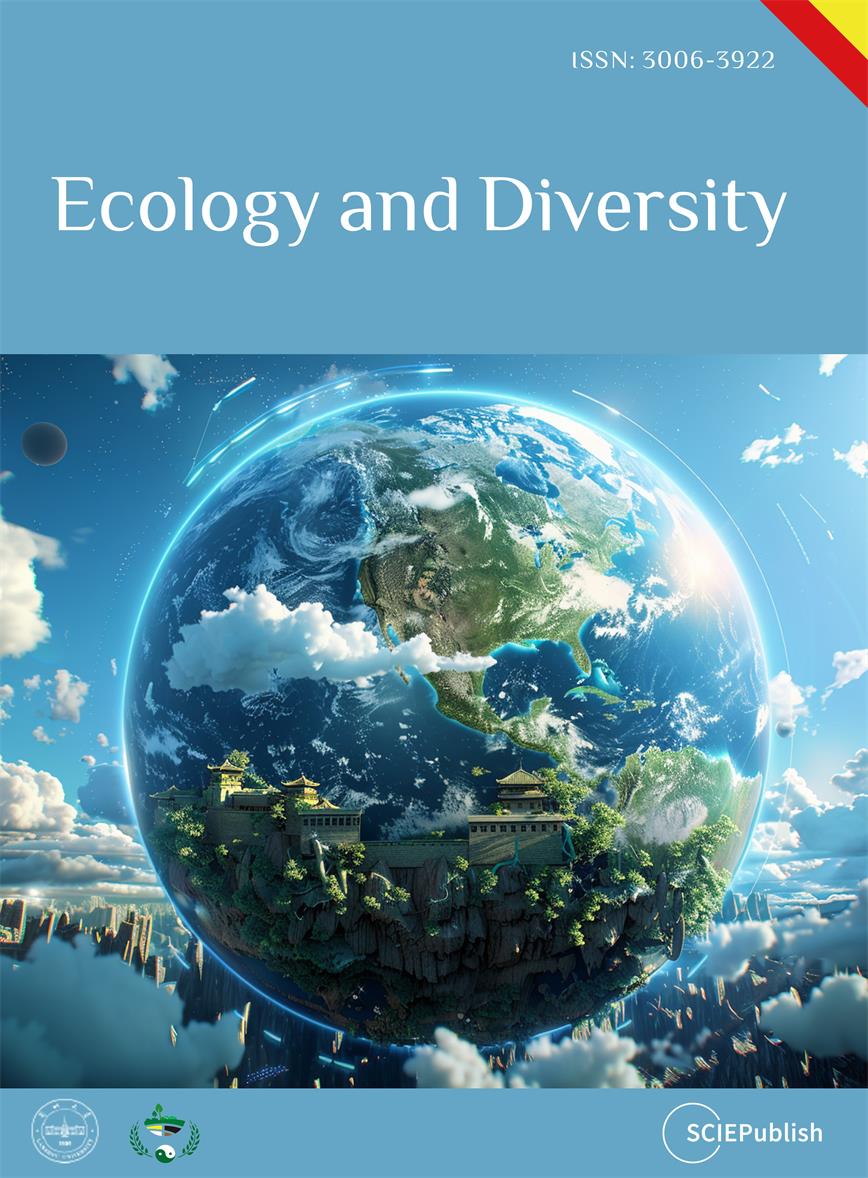Found 8 results
Open Access
Article
30 October 2025Postural Education Program for Indigenous Children in School: Case Study
To investigate whether a Postural Education Program (PEP) is capable of promoting changes in body knowledge and self-perception of posture among indigenous school-aged children. The study included 9 indigenous children with a mean age of 8 years, of whom 7 completed both the initial and final evaluations. The PEP consisted of four sessions, each lasting approximately two hours, which included an initial assessment, theoretical-practical classes on postural education, and a final assessment. Responses to the Self-bodpos questionnaire, collected at the beginning and end of the sessions, were tabulated using SPSS 22.0 and analyzed through descriptive statistics and the Wilcoxon test, with the significance level set at α ≤ 0.05. Verbal information collected from the focus group was analyzed using content analysis techniques. Among the 7 participants who completed both evaluations, 4 showed statistically significant differences in four of the seven items assessed by the Self-bodpos. In addition, positive outcomes were observed in the theoretical knowledge questionnaire and in the focus group discussions. The PEP was effective in promoting changes in body knowledge and self-perception of posture among indigenous school-aged children.

Open Access
Article
17 October 2025Bioenergy Technology and Carbon Intensity in U.S. and China: Threshold Roles of Capital Accumulation, Education and Inequality
Bioenergy technology holds significant promise for reducing carbon intensity and fostering sustainable development, yet its impact remains unclear. This article employs both a panel threshold model and a random forest model, analyzing data from the primary administrative regions in the United States and China to explore the threshold effects and regional heterogeneity of bioenergy technology on carbon intensity, where the bioenergy technology is measured using patent data. In the United States, the impact of bioenergy technology on carbon intensity initially shows a positive effect, which later turns negative as per capita capital stock increases. The technology’s inhibitory effect strengthens with higher levels of education but becomes insignificant as the Gini coefficient rises. In China, increasing per capita capital stock shifts the impact of bioenergy technology from negative to insignificant, while higher education levels enhance its inhibitory effect. The Gini coefficient, however, does not significantly affect the impact of technology. Additionally, these threshold effects exhibit notable regional variations. The study provides cross-country evidence of how institutional and structural conditions shape the carbon mitigation effects of bioenergy technology, offering practical insights for policies that combine trade facilitation, education, and inequality reduction with low-carbon energy transitions.

Open Access
Article
23 September 2025Promoting Sustainable Development through Community Education on Flood- and Storm-Resistant Architecture
Pakistan is experiencing climate-induced disasters such as floods and storms with an increased frequency and intensity every single year. This study aims to explore the integration of resilient architecture into environmental education as a pathway toward sustainable development and disaster risk reduction. The research examines current levels of understanding regarding flood- and storm-resistant building practices and identifies key barriers to their adoption in high-risk regions of Pakistan. The study used a mixed-methods approach by administering surveys. These surveys were administered to 500 community members in different cities of Sindh and Punjab. The study also incorporated two in-depth case studies: the Heritage Foundation’s low-cost housing initiative in Makli, Sindh, and the Aga Khan Agency for Habitat’s Safe Housing Program in Chitral, Khyber Pakhtunkhwa. These cases provide valuable insights into effective, culturally appropriate, and scalable models of resilient construction in Pakistan. Findings of the present study reveal that public awareness of resilient architecture is below a satisfactory level, with common misconceptions. Challenges, including high costs, lack of technical knowledge, and minimal government support, were identified as significant obstacles. Despite these issues, communities showed strong interest in learning about safer building practices when exposed to practical examples and local success stories. The study recommends integrating resilient construction education into community outreach, school curricula, and builder training programs. It also advocates for greater government involvement, financial incentives, and replication of proven models to foster widespread adoption of resilient architecture for long-term sustainability.

Open Access
Perspective
26 August 2025Expanding Private Capital Investment in Universities to Biodiversity Conservation
Biodiversity is essential for human well-being, and serves as the green engine for education, science, technology and health. China’s prosperous private entrepreneurs have established hundreds of private colleges and universities with several newcomers positioned as world-class research universities. Unfortunately, biodiversity conservation education and researches appear overlooked in these institutions. Universities, particularly the top-tier universities, serve as critical hubs where talent, knowledge, and technology concentrate. Private capital’s flexible management framework and rapid response to emerging academic disciplines enable universities, enterprises, and markets to collaborate effectively in developing tools and equipment for biodiversity assessment and monitoring. Expanding huge private capital investment in universities to biodiversity conservation could spur broader investment in ecological products in the future, while would also offer an opportunity for the universities to achieve their ambitions.

Open Access
Article
18 August 2025Generational Shifts in Fertility Behaviour: Evidences from an Ethnographic Study from Howrah District of West Bengal, India
This ethnographic study examines generational shifts in fertility behaviour among ever-married women in Howrah district, West Bengal, India—a region characterised by the convergence of agrarian rural and rapid urbanisation. Utilising a cross-sectional sample of 665 women across three generational cohorts, the analysis applies a negative binomial regression framework to assess the impact of socio-demographic, economic, and cultural determinants on fertility outcomes. One-way ANOVA result reveals a significant generational decline in mean number of children (p = 0.004); with participants of Generation I (1.89) showing the highest mean number of children than the participants of Generation III (1.38). Negative binomial regression results showed that women from Generation II (IRR = 0.99; CI: 0.72–1.37; p < 0.001) and Generation III (IRR = 0.95; CI: 0.60–1.49; p = 0.001) exhibiting significantly lower fertility compared to those from Generation I. Key predictors of reduced fertility include higher educational attainment among women (IRR = 0.95; CI: 0.72–1.26; p < 0.01) and their spouses (IRR = 0.99; CI: 0.85–1.25; p < 0.05), engagement in white-collar occupations (IRR = 0.93; CI: 0.72–1.22; p < 0.01), prioritisationof leisure time (IRR = 0.51; CI: 0.85–1.18; p < 0.05), fewer siblings (1–2) of the husband (IRR = 0.99; CI: 0.81–1.28; p < 0.05), higher household crowding (HCI) (IRR = 0.99; CI: 0.85–1.14; p < 0.05), and greater economic status within the upper expenditure quintile (IRR = 0.95; CI: 0.79–1.15; p < 0.01). Fertility preferences increasingly reflect modern aspirations related to lifestyle enhancement and personal autonomy. However, traditional influences—such as perceived necessity of children for life fulfilment and old-age dependency—continue to exert a reduced but noticeable effect. Significantly, higher fertility rates among Muslim participants (IRR = 1.04; CI: 0.81–1.14; p < 0.01) highlight the enduring impact of religious and economic disparities. IDIs observed a clear generational shift; older generations follow traditional childbearing norms, while younger ones lean toward modern views. The study concludes that fertility transition in the Howrah district is shaped by a dynamic interplay between persisting traditional norms and evolving individualistic values, positioning generational change as a crucial lens for interpreting India’s ongoing demographic transformation.

Open Access
Article
24 July 2025Anthropological Pathways to Cultural Understanding: “Language Learning Circles in Early Childhood Bilingual Education in the U.S.A.”
This article presents a literature review that employs an anthropological perspective to investigate the role of Language Learning Circles (LLCs) in fostering early bilingual development and cultural identity among Hispanic children in the United States. As the Spanish-speaking population grows, the need for culturally grounded language education becomes more urgent. LLCs, rooted in educational and anthropological traditions, serve as structured, dialogic spaces where language learning is tied to cultural practices such as storytelling, music, and rituals. Drawing on theories of language socialization, cultural artifacts, and communicative competence, this paper situates LLCs within broader anthropological discussions on identity, belonging, and community building. By highlighting how LLCs promote linguistic diversity, foster cross-cultural understanding, and employ inclusive teaching methods, the article offers insights into how early childhood education can serve as a powerful site for cultural transmission and resistance. Special focus is given to the implications for Hispanic families navigating bilingualism and educational equity in the U.S.

Open Access
Article
01 April 2024Identity, Secondary Vocational Education Options and Return on Investment: Evidence from Children of Rural Chinese Families
With the continuous improvement of living standards, the importance of educational choice becomes more and more prominent. Based on the data of China General Social Survey (CGSS), a simultaneous equation model of identity, secondary vocational education choice and investment return is constructed. On the basis of fully considering endogeneity and sample selection bias, this paper analyzes the influence of identity on secondary vocational education choice and investment return by means of instrumental variables and propensity score matching (PSM). It is found that class differentiation is the main factor affecting class identity. The more blurred class differentiation, the higher class identity. Class identity has a significant positive impact on identity. The higher class identity, the easier it is to form identity. Identity has a direct positive impact on personal investment return. The stronger the identity, the higher the investment return. At the same time, identity has a significant positive impact on the choice of secondary vocational education. The stronger the identity, the more inclined to choose secondary vocational education. Compared with individuals with junior high school education, individuals with secondary vocational education have a higher return on education investment. Therefore, identity can not only directly improve an individual’s return on investment, but also improve the possibility of an individual’s choice of secondary vocational education, thereby improving an individual’s return on education investment, and ultimately increasing an individual’s return on investment.

Open Access
Article
06 February 2024Geographical Discrepancies in Higher Education in Sweden
There is a growing awareness of the importance of higher education in Sweden to reduce social differences in society. There are also various mechanisms that individuals relate to that favour either the status quo or change based on an ideal of higher education. Individuals live in a geographical context with a number of ‘key actors’ who influence the perception of higher education with varying degrees of intensity. Paradoxically, despite several reforms to broaden recruitment, it can be seen that relative inequalities persist in terms of residents with higher education in Sweden, not least from a regional perspective. The purpose of this article is to shed light on geographical differences in the higher education level of the population over time from a Swedish perspective. The study shows that higher education has a geographical centre-periphery perspective, but not exclusively. There are thus additional influencing factors that in various ways relate to the social context in which the individual is located. We can conclude from our empirical data that the reforms implemented to broaden recruitment have not had the desired effect, especially for the group of men. We find it likely that what differentiates women and men is who their individual ‘key players’ are and how they interact. From an academic education perspective and as an intermediary of higher education, there is therefore a challenge to be able to identify who these “key players” are in order to be able to be an important actor in contributing to the desired broader recruitment that the government is striving to achieve.
